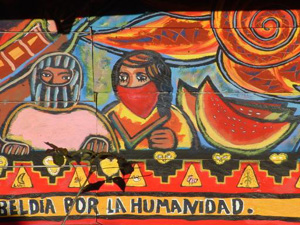DominionSections
Browse Articles
- IndependentMedia.ca
- MostlyWater.org
- Seven Oaks
- BASICS Newsletter
- Siafu
- Briarpatch Magazine
- The Leveller
- Groundwire
- Redwire Magazine
- Canadian Dimension
- CKDU News Collective
- Common Ground
- Shunpiking Magazine
- The Real News
- Our Times
- À babord !
- Blackfly Magazine
- Guerilla News Network
- The Other Side
- The Sunday Independent
- Vive le Canada
- Elements
- ACTivist Magazine
- The Tyee
- TML Daily
- New Socialist
- Relay (Socialist Project)
- Socialist Worker
- Socialist Action
- Rabble.ca
- Straight Goods
- Alternatives Journal
- This Magazine
- Dialogue Magazine
- Orato
- Rebel Youth
- NB Media Co-op
Radio
Zapatistas and Supporters Celebrate 10 Years of Colourful Resistance
February 3, 2004
Zapatistas and Supporters Celebrate 10 Years of Colourful Resistance
OVENTIC, Chiapas--On a damp, foggy night in the tiny town of Oventic, way, way up in the mountains of the Sierra Madre de Chiapas, about 1,500 people gathered to celebrate the 10th anniversary of the 1994 Zapatista uprising.

A colourful mural in a Zapatista village. The text reads 'rebellion for humanity'. photo: Simon Helweg-Larsen
The Zapatistas are the indigenous rebel group in Chiapas, Mexico, that shocked their country when they occupied several Chiapan towns on January 1, 1994, demanding autonomy, dignity, and basic necessities. Initially as surprised as everyone else, the Mexican army soon recovered and violently quelled the rebellion. But by the time the rebels retreated to the highlands, it was clear they had captured the imagination of sympathizers around the world. Public shows of support came from all over Mexico, as well as from labour and civil society groups from Nebraska to Rome.

photo: Simon Helweg-Larsen
"It's like a folk festival here" said Canadian writer Simon Helweg-Larsen. "A surreal, radical, political, Zapatista folk fest." Indeed, but for the masks worn by the local people, the festive atmosphere made it easy to forget that we were in a low-intensity war zone. Bright murals decorated outside walls everywhere, mostly full of slogans and symbols of life and hope. Outside Oventic, however, in several surrounding communities, conflict continues to rage. The Fray Bartolomé de las Casas Human Rights Centre reported threats of "displacement" against residents of nine Zapatista communities shortly before the anniversary celebrations. This past week, Mexico City's La Jornada reported 23 homes burned in the town of Nuevo San Rafael.

photo: Simon Helweg-Larsen
As well, observers say that poverty and standards of living have worsened in Chiapas in the last 10 years. The Zapatista uprising was timed to coincide with enactment of the North American Free Trade Agreement (NAFTA), and everything they said about NAFTA is proving to be true, said Peter Brown of Schools for Chiapas, a San Diego-based nonprofit organization. "There's more hunger. There's more people being forced off the land," he continued. With millions of tons of cheap, subsidized, American corn flooding the Mexican market and forcing down prices, smaller growers can't afford to keep farming.
Chiapas Indymedia
Fray Bartolomé de las Casas Human Rights Centre
Schools for Chiapas
International Service for Peace, Chiapas
ChiapasLink
Students Taking Action in Chiapas, Montreal
It's anyone's guess as to what to expect in the future. The rebels have already voiced their opposition to the Free Trade Area of the Americas, the hemisphere-wide extension of NAFTA, and Plan Puebla Panama, a massive infrastructure project that would cut through thousands of acres of indigenous lands. Just before the anniversary, La Jornada published a speech by Zapatista Comandante David, entitled "The Time Has Come to Act." In it the commander urged indigenous people in Mexico to unite and claim their rights, because "it is clear that no government will give us the right and the liberty to live with dignity."
Related articles:
By the same author:
Archived Site
The Dominion is a monthly paper published by an incipient network of independent journalists in Canada. It aims to provide accurate, critical coverage that is accountable to its readers and the subjects it tackles. Taking its name from Canada's official status as both a colony and a colonial force, the Dominion examines politics, culture and daily life with a view to understanding the exercise of power.